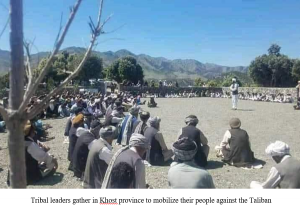Afghans Are Rising Up Against the Taliban More Than Ever Before
People’s movements have recently forced the Taliban to retreat from large parts of the country.
The intensity of the war and its spread to all parts of Afghanistan caused the withdrawal of the Afghan national security forces from a district in the north, and thousands of civilians in the southern part of the country have fled their homes to escape violent attacks by the group after the withdrawal of US forces from military bases in Afghanistan.
national security forces from a district in the north, and thousands of civilians in the southern part of the country have fled their homes to escape violent attacks by the group after the withdrawal of US forces from military bases in Afghanistan.
The retreat of the Afghan forces was for two reasons: First, the Taliban routinely build a human shield from locals in their attacks on cities and villages to prevent airstrikes. The Afghan forces airstrikes inflict heavy losses to the Taliban, which is why the Taliban are terrified of them. “The recent (air) operations were very effective for suppressing the Taliban,” Afghan Army Chief of Staff told TOLO news. Secondly, the government wanted the people to face the Taliban as well, because the mentality toward the Taliban was largely vague.
Some believed that the Taliban had changed from the past and was no longer the Taliban of the 1990s. This mentality has been created by Taliban-linked propaganda networks.
Also Read : India, Afghanistan share immensely deep, rather romantic relationship: Hamid Karzai
There were even videos showing girls’ schools operating in Taliban-controlled areas. In reality, however, the Taliban do not allow girls’ schools to operate in any area under their control, nor do they allow women to leave their homes as they once did. This behavior is exactly like the mid-1990s. Today, large parts of the Afghan population know that the Taliban kills journalists and religious scholars. Taliban is the one that destroys bridges, schools, and clinics. That is why the government wanted to make the Taliban’s actions clear to the people once again. Popular uprisings in northern as well as central Afghanistan have led to the recapture of Taliban-held areas.
Local movements were also deployed in parts of the country to resist possible Taliban attacks. The people’s movement against the Taliban has its advantages and challenges. The most vital advantage of local mobilization against the Taliban is the creation of a new front against this group. People’s fronts can greatly enhance the ability of the Afghan National Security Forces to strengthen other areas that the Taliban are seeking to capture so that the latter cannot seize them. On the other hand, local movements also prevent the Taliban from recruiting men and generating revenue.
The Taliban’s income derives from far more than just the drugs business; they constantly take the money and local products from the people as “tithe,” “zakat,” and so on. They are collecting money by imposing a strict version of Sharia law. The group’s annual income from 2011 onward was estimated to be $400 m (£316 m). However, it is believed to have significantly increased in recent years and could be as high as $1.5 bn. They even get the food they need from the people. In addition, the Taliban are recruiting young people to fight against the government by propagating in the villages and remote areas of Afghanistan.
The Taliban try to intoxicate the youth mentality by showing green and red gardens. Many of the young men who are fighting for the Taliban do not have a fixed mindset about the group’s performance.
The Taliban are rapidly influencing their ideas through propaganda. The locals’ treatment of the Taliban means that the group can no longer recruit from among the people.
However, popular uprisings also have challenges. The most important challenge is the return of some warlords that the government has marginalized over the years. Of course, people outside the cities still maintain contact with their local warlords. The return of these warlords could once again call into question the authority of the government in the long run. For this reason, while the government welcomes the spontaneous uprising of the people against the Taliban, it also has its own concerns about the return of the old warlords to the formation of new nuclei of warlords.
Also Read : India’s journey from aid recipient to a donor
Prospects for a lasting, comprehensive agreement to end the Afghan conflict, never bright, seem increasingly dim. The Taliban, showing no seriousness in participating in the talks and failing to agree to a ceasefire, bear most of the responsibility for the continuation of the current bloody situation.
In the wake of failed peace negotiations, the government can be expected to express its confidence in the country’s ability to soldier on. It would insist that the Afghan National Security and Defense Forces are capable of defending the state, even in the face of almost certain increased Taliban attacks of greater scope and intensity. On the other side, it seems that a large population coming ground against the Taliban, “If the central government does not concentrate, we will witness a human tragedy and human catastrophe, thus we made the decision to stand with the Afghan national forces against Taliban,” said Lotfullah, a resident in Takhar province.
If the government can accurately manage the spontaneous movements of the people and prevent the people from becoming tools for the warlords, not only has it been able to create a new front against the Taliban, but it has also been able to mobilize the public opinion to a large extent. Although many people are less satisfied with the government’s performance and the government is facing criticism, most people prefer this Afghan Republic government to the Taliban.
